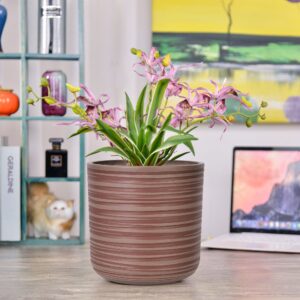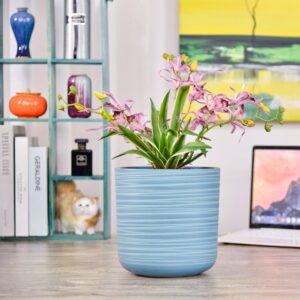Where in Your Home Should You Place Decorative Planters of Different Sizes and Shapes? What Visual Effects Can They Create?
Decorative planters come in a variety of sizes and shapes, each offering unique opportunities to enhance your indoor spaces. Knowing where to place them can make a significant difference in the overall aesthetic and atmosphere of your home. For American homeowners looking to maximize the visual impact of their indoor greenery, here's a guide on placing planters of different sizes and shapes:
Small Decorative Planters
Small planters are versatile and can be used in numerous locations to add subtle touches of greenery and style.
- Location Ideas:
- Shelves and Bookcases: Small planters fit perfectly on shelves, adding a pop of color and life among books and décor items.
- Windowsills: They can sit neatly on windowsills, enjoying the natural light and adding a pleasant view.
- Desks and Tabletops: Small succulents or air plants in decorative pots can brighten up workspaces and tabletops without taking up too much room.
- Nightstands: A small planter on a nightstand can bring a calming touch to the bedroom.
- Mantels: Arrange small planters along a mantelpiece for a touch of natural elegance.
- Visual Effects: Small planters often serve as accents, adding detail and visual interest to smaller areas. They can soften hard edges and introduce a touch of nature to various surfaces. Grouping a few small planters together can create a more impactful display.
Medium-Sized Decorative Planters
Medium-sized planters can act as more significant decorative elements, capable of making a statement without dominating a space.
- Location Ideas:
- Side Tables: A medium-sized planter on a side table in a living room or bedroom can be a stylish focal point.
- Entryways: Placed on a console table in an entryway, they can create a welcoming and vibrant first impression.
- Corners: Medium-sized floor planters can effectively fill empty corners in smaller rooms, adding height and visual interest.
- Room Dividers (Subtly): A row of medium-sized planters can subtly suggest a division in larger spaces without fully blocking the view.
- Visual Effects: Medium-sized planters can help to balance furniture arrangements and add a sense of scale to a room. They can draw the eye and introduce a focal point that complements the surrounding décor.
Large Decorative Planters
Large planters are ideal for making a bold statement and bringing a strong sense of nature indoors.
- Location Ideas:
- Floor Planters in Corners: Large floor planters are perfect for filling spacious corners in living rooms, dining rooms, or even large bathrooms.
- ** рядом with Furniture:** Placing a large planter рядом with a sofa or armchair can create a lush and inviting reading nook or conversation area.
- Entryways (Large Spaces): In grand entryways, a large statement planter can create a significant visual impact.
- Defining Zones (Open Plan): Use large planters to visually separate different living areas in an open-plan layout.
- Visual Effects: Large planters can anchor a room and create a strong connection to the outdoors. They can add drama, height, and a feeling of fullness to a space, making it feel more alive and welcoming.
Decorative Planter Shapes and Their Placement
The shape of a planter can also influence where it should be placed and the visual effect it creates:
- Round Planters: These tend to have a softer, more organic feel and can be placed on round tables or used to soften angular spaces. They work well in a variety of settings, from casual to more traditional.
- Square or Rectangular Planters: These shapes often have a more modern or formal look and can be placed on shelves, rectangular tables, or used in linear arrangements to emphasize structure and clean lines.
- Tall, Cylindrical Planters: These are great for adding height and drama, especially in corners or alongside furniture. They can make a ceiling appear higher and are suitable for taller plants.
- Wide, Shallow Planters: These are ideal for creating a display of multiple smaller plants or for showcasing plants with spreading foliage. They work well as centerpieces or on wider surfaces.
- Hanging Planters: These are perfect for utilizing vertical space and adding visual interest at different heights. They can be placed near windows or in corners to create a dynamic and space-saving display.
By carefully considering the size and shape of your decorative planters and thoughtfully placing them in your indoor spaces, you can create a visually appealing, balanced, and inviting home environment that showcases your plants and enhances your overall décor.
Article copyright by GreenShip


Comments
Post a Comment